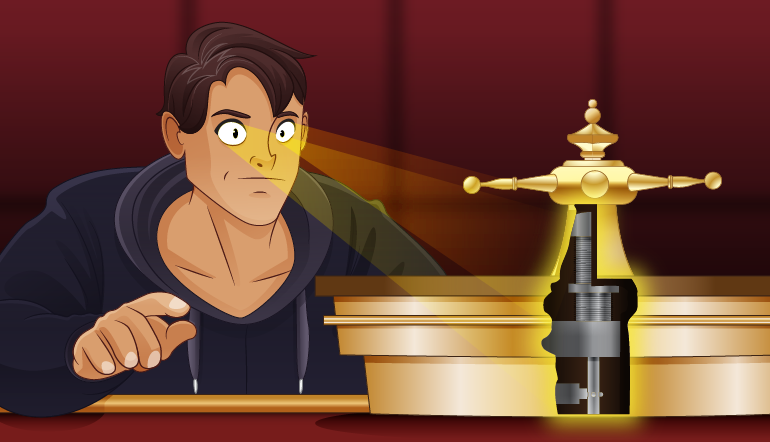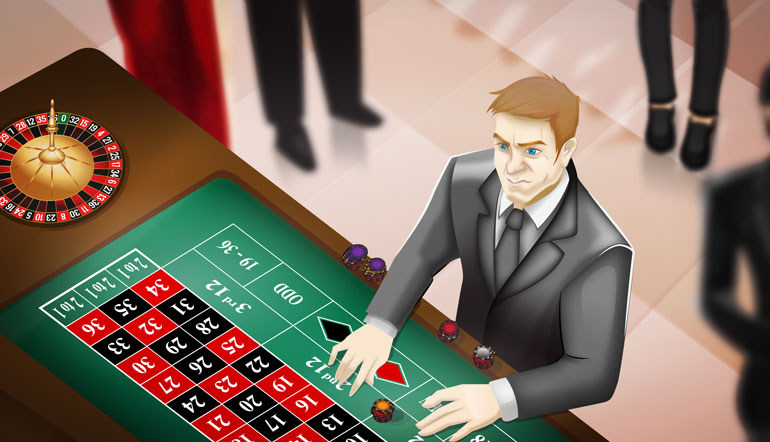In this article, I write about Green Zero pockets in roulette games. I compare the house edge of one to three green zero pockets and focus on the importance of even-chance betting using the La Partage, also known as the half-back rule.
I also describe how you can use the single-zero pocket as a timing marker to help predict roulette outcomes.
Table of Contents
- Green Zero Pockets and the House Edge
- A Little Roulette Knowledge is Power
- Up Your Roulette Game
- Green Zero Pay-Out Odds and Chances
- Using Green Zero as a Timing Marker
- Why Pro Roulette Gamblers use La Partage
- Green Zero Roulette Summary
Green Zero Pockets and the House Edge
Single-zero wheels are the most-favored roulette games. These roulette tables are based in Europe from where the game originated. American roulette wheels contain two Green Zero pockets and there are even three Green Zero roulette wheels.
The house edge is higher even though the payout odds remain the same despite the additional Green Zero pockets in the two American variations. For instance:
- On a Single-zero [0] European roulette wheel the house edge is 2.7%
- A Double-zero American roulette wheel with two green zero pockets i.e. single-zero in one pocket [0] and a double-zero in the other pocket [00] has a house edge of 5.26% – Almost double the house edge to that of the single-zero European wheel.
- With a Triple-zero wheel commonly found in America, [0], [00], [000] the house edge is 7.69%.
A Little Roulette Knowledge is Power
- There Are No Hidden Roulette Powers: The first important aspect about Green Zero pockets is they don’t have any special powers such as ball attracting forces.
- Roulette Games Are Fair: Roulette wheels found in regulated land-based or online casinos – manufactured by independent companies – maintain a near-perfect balance. After thousands of games, the collected data of those outcomes is unlikely to show a favorable bias for Green Zero pockets.
- Secure Early Roulette Profits: Licensed casinos generate profits from a house edge designed into games. The Green Zero pocket or pockets represent the casino’s house edge. Casinos gain value or profits through the expectation of long-term wagering. This means, the more roulette games we as players bet on, the more likely we’ll end up losing.
Up Your Roulette Game
As a roulette bettor, there are some important aspects you should be aware of regarding Green Zero, including how to take advantage of a lower house edge. If you want to gamble like a roulette pro, continue reading.
Let’s cut to the chase. If you want to bet like a roulette pro you need to bear in mind that,
- People bet on double and triple zero tables because they are new to the game and normally the minimum bet size is lower than on single-zero roulette wheels.
- You should only bet on roulette games displaying a single green zero pocket since the house edge is lower. Single-zero (#0) pocket roulette wheels are found mostly in European land-based casinos and within online casinos.
- The house edge is 7.69% with Triple-zero pockets (#0, #00, #000) on a wheel: x39 pockets. It’s 5.26% with double-zero pockets (#0, #00) on a wheel: x38 pockets. The house edge is 2.7% with a single-zero pocket (#0) on a wheel: x37 pockets.
- But the house edge is only 1.35% with a Single-zero pocket (#0) on a wheel: x37 pockets using La Partage, known as the half-back rule.
- If you’re going to bet on the even-money chances, think “La Partage” when you spot single-zero wheels. Just make sure the half-back rule is in play.

In my view, the appearance of Green Zero colored pockets is important to players in three ways:
1. Green Zero Payout Odds and Chances
Firstly, since the green color stands out from the x18 Red and x18 Black pockets, in the minds of new roulette players green zero pockets might have a better chance of occurring.
There’s nothing wrong with how people pick numbers to bet on so long as they’re aware the payout for en plein (straight up) wins on any zero pocket is 35-1, the same payout odds as any other number on a roulette wheel.
To avoid becoming a zero chaser, know that zero outcomes have no greater chance of occurring or occurring more frequently over any other numbered pocket on a roulette wheel.
2. Using Green Zero as a Timing Marker
On single-zero wheels, the green color – to some professional roulette players – acts as a timing marker.
The player fixes his gaze to the far side of the wheel. He registers the passing of the green zero (which is easy to notice i.e., it’s the “marker”) and in his peripheral vision he is aware of the slowing speed of the ball.
He guesstimates the number of revolutions around the ball track the ball might make before it leaves the ball track.
The objective of this motion awareness activity is to calculate the falling zone on the wheel the ball might end up resting in (subject to the ball not bouncing or deflecting too far away from that area) moments before “no more bets” is called by the croupier.
The player can then make wagers particularly on “call bets,” e.g. Voisins du Zero, Tiers du Cylindre, Orphelins, or on Neighbour bets.
In land-based casinos, players move chips near the croupier when calling out their bets because only croupiers can place bets on the racetrack area. When playing in online casinos, players are allowed to place their own bets on the racetrack betting layout.
This predictive practice of working out when the ball might fall onto the wheel and in what area of the wheel is a skill one becomes better at rather than it all being down to mere guesswork.
Although part of the decision-making process comes from guessing, the process is more about attempting to estimate the number of revolutions around the wheel (that rotates in the opposite direction to the ball) the ball might travel before falling into the wheel.
It’s at this stage, after a decision has been reached, within seconds of the croupier’s “no more bets” call when bets are placed.
If you’re able to predict the correct area the ball will fall and come to rest on the wheel, you can gain a strong winning advantage.
3. Why Pro Roulette Gamblers use La Partage
The “La Partage’ rule is found on single-zero roulette games (#0) mostly in the UK and other European countries. If betting in an online casino on the outside even-money chances, check this rule applies.
With La Partage, the house edge is 1.35% instead of 2.70%.
The rule comes into play when zero is the outcome and there are bets on one or more of the six even-money outside chances, i.e. Low/High (1 to 18 and 19 to 36), Even/Odd, and Red/Black.
All even-money bets lose half of the chip values wagered. So, if you wagered $50 on Red and the outcome is green zero, you’ll lose half, so you’ll get back $25.
The “Surrender” rule in double-zero roulette games acts in the same way as La Partage does on single-zero wheels no matter what zero occurs (#0, #00). And the house edge is 2.63% instead of 5.26%. This arrangement is common in Atlantic City, but not in all states in the U.S. nor online.
Many land-based casinos in the UK and online casinos don’t pay half back when games result in a zero. It doesn’t follow that all single-zero roulette games pay the half-back rule. For example, in some land-based casinos where a progressive random paying jackpot is in play (via touch bet electronic roulette terminals) in case of zero, the bettor will lose all even-money outside wagers.
Where the half-back rule isn’t in play, a player can negate losing all his stake by covering the Green Zeros should one occur.
However, the more often one or more Green Zeros are wagered on, as backup insurance bets, the more likely those extra fractional wagers will mount up. This will expose one’s bankroll to being depleted. So, it’s only a clever idea to back up outside wagers over a limited number of games.

Green Zero Roulette Summary
Although the green zero forms the casino’s house edge, a green zero pocket can be beneficial to players if using as a timing marker or when betting on even-money options with the half-back rule.
When betting big on even-money outside chances, try to find a single-zero roulette table where the La Partage rule is in play so that, in the worst-case scenario, you’re only going to lose half of your stake when green zero occurs.
If you’re a half cup full kind of a person, you’re going to reason that La Partage wins you half back of what you would’ve lost had the rule not been in play.





















